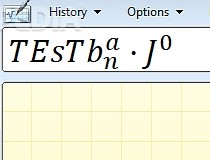
#MATH INPUT PANEL ALTERNATIVE WINDOWS ISO#

A reference like B1048576:C1048576 does not have a sticky end row anchor, because only one row is referenced.įunction WEEKNUM strictly complies with ODF 1.2 function definition and ISOWEEKNUM has been introduced.The column or row will become sticky then, in the example row 1048576.For example a reference B2:B1048575 when inserting two rows will be updated to B2:B1048576.When inserting columns or rows and updating a reference the end reference would be shifted out of the sheet bounds, the reference is anchored at the last column or row instead of generating a #REF! error.AMJ or 1048576, the end column or row is sticky now and not moved when inserting or deleting columns or rows. For range references that encompass at least two columns or rows where the end reference points to the last column or row, i.e.All internal column names are unique within one table, which is reflected when displaying existing formula expressions.The generated column names are updated if text is entered in such an empty cell.For example, inserting two columns before the third column of a table the generated names are Column3 and Column4. When inserting columns within a table, numbered column names are internally generated for empty header cells, starting with the column number within the table.This is automatically reflected in existing formula expressions. For example, having two FooBar header cells the column names will be FooBar and FooBar2.

When duplicating header cell content, duplicated column names internally are numbered.When deleting header cell content, formulas referring the column name continue to function and are still editable using the previous name.Modifying header cell content updates the internal table column names.Saving to OOXML, the defined database ranges are now exported as elements.Saving to OOXML, structured references are now written (not transformed to A1 notation any more) and the table context is maintained.Internal names are imported from OOXML spreadsheet documents and continue to function in formula expressions.For this, for new database ranges without header cells or with empty header cell content, internal names are generated, for example Column1, Column2.




 0 kommentar(er)
0 kommentar(er)
